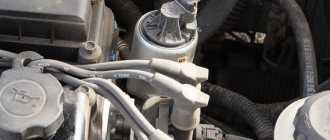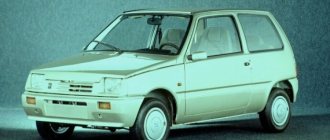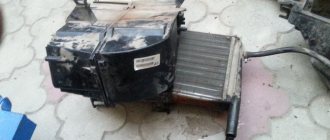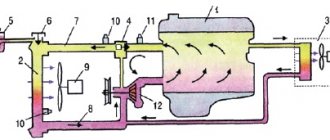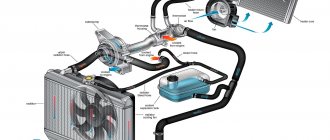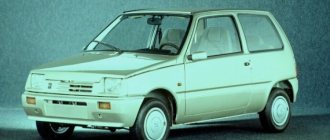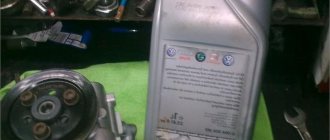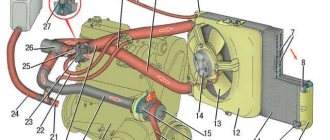Today we’ll talk about the crankcase on Kalina with an 8-valve engine. And to be more precise, about cleaning this system. Crankcase gases straight from the crankcase (hence the name) are sent mixed with air to the intake manifold for re-burning, thus saving a certain percentage of fuel. So, along with the gases, oil particles enter the system and clog it.
It is this oil that needs to be cleaned from the crankcase ventilation system. Over time, plaque forms on the walls of the hoses, which impedes the passage of gases.
In the Kalinovsky engine, in the valve cover, there is a special separator that separates crankcase gases from the oil. It gets clogged the most. So, let's get started. The entire ventilation system consists of 3 pipes. We need to unscrew them.
Then remove the valve cover. There are two bolts on the back side, unscrew them and get to the separator.
The easiest way to clean it from oil and deposits is in a bath of gasoline or solvent.
While the separator is acidifying, you can work on the pipes. In general, if they are heavily soiled, it is advisable to replace them with new ones. In my case, I replaced only one - coming from the valve cover to the air filter pipe. The rest were washed with carburetor cleaning fluid (great stuff, it corrodes absolutely everything). The separator itself can also be washed a second time with this thing.
We wipe everything with a clean cloth and put it back together as it was. Pay attention to the condition of the valve cover gasket. It is considered disposable and it is better to replace it with a new one each time you remove it in order to avoid oil leaks.
Modification of the crankcase ventilation system Kalina 8 valves
This system could be improved a little. One of the 3 pipes supplies crankcase gases directly to the throttle valve assembly next to the IAC. If they contain oil, it will definitely settle there. This is how the IAC becomes clogged. So, to avoid this, you can embed a regular fuel filter right in the middle of this pipe.
It will trap oil particles contained in crankcase gases. After a few hundred kilometers, you will see for yourself. Monitor the condition of this filter and promptly change it to a new one. On average, as practice shows, it needs to be changed every 1000 kilometers.
Video
Tools:
- Open-end wrench 10 mm
- Open-end wrench 13 mm
- Open-end wrench 17 mm
- Medium Phillips screwdriver
Parts and consumables:
- Gasoline/kerosene
- Rags
- Sealant
- Automotive compressor
- Cylinder head cover gasket (if replacement is needed) -2108-1003270-10
Read more: Brake caliper tightening torque
Notes:
The crankcase ventilation system of the VAZ Lada Kalina 1118 tends to accumulate tarry deposits from crankcase gases, which make it difficult to remove these gases into the engine cylinders for combustion. Because of this, the gas pressure inside the engine increases and oil leaks through the seals appear. We recommend cleaning the crankcase ventilation system before each oil change.
1. Remove the decorative plastic engine cover.
2. Loosen the clamp and disconnect the hose of the large branch of the crankcase ventilation system from the air supply pipe.
3. Disconnect the second end of the large crankcase ventilation system hose from the fitting on the cylinder head cover and remove the hose.
4. Similarly, remove the hose of the small branch of the crankcase ventilation system by disconnecting it from the fittings of the throttle assembly and the cylinder head cover.
5. Remove the supply hose of the crankcase ventilation system by disconnecting it from the fittings of the cylinder block and the cylinder head cover.
6. Rinse the hoses with gasoline or kerosene, blow with compressed air and dry. Clean the holes in the fittings and pipes for connecting the hoses.
7. Unscrew the two fastening nuts and remove the cylinder head cover.
8. Unscrew the long 1 and short 2 bolts securing the oil separator from the inside of the cylinder head cover and remove the washers.
9. Remove the oil separator housing.
10. Remove the mesh pack from the cylinder head cover.
11. Thoroughly rinse the screens, oil separator housing and cylinder head cover with kerosene.
12. Turn the meshes in the bag so that they are oriented in the same way, and install the bag in the lid so that on one side it rests against the protrusions in the lid, and on the other side you can see the hole for the bolt that secures the oil separator of the VAZ Lada Kalina 1118.
13. Install the oil separator housing and tighten its mounting bolts.
14. Check the condition of the cylinder head cover gasket and replace if necessary.
15. The hoses of the crankcase ventilation system and the cylinder head cover of the VAZ Lada Kalina 1118 are installed in the reverse order of removal.
The article is missing:
- Photo of the instrument
- Photos of parts and consumables
- High-quality photos of repairs
If, while operating a LADA car, you notice that during load (when the air conditioner is running, the heating is on, etc.) in a traffic jam, the engine begins to operate unstably (troits, pulls poorly, etc.), perhaps the reason lies in the ventilation system crankcase The article proposes to solve the problem by installing a PCV valve from a foreign car.
Purpose of the adsorber purge valve
In the Lada Kalina model, as in principle in any other car equipped with distributed fuel injection, an adsorbing system is necessary to localize the resulting gasoline vapors. They accumulate inside the tank after the engine stops, and after a certain time necessary for the transformation of these vapors into a condensation state, they turn back into liquid fuel. The remaining volume of vapor that failed to return to the tank moves to the adsorber, where it is retained by two valves. The first (gravity type) is necessary to prevent fuel spillage when the LADA Kalina body turns over (in an accident, etc.), and with the help of the 2nd, the pressure indicator inside the tank is monitored.
Do you need a pipe from the breather to the pan? (do not delete)
#1 anchous814
- Users
- 33 messages
- Registration 10-July 08
- Top
- Complaint
#2 yurecgod
- Top
- Complaint
#3 July
- From: Ukraine
- Car: VAZ 2104, VAZ 2101
Message modified: July, 02 July 2010 - 10:05.
- Top
- Complaint
#4 djurka
the breather not only throws out, but also draws in air
- Top
- Complaint
#5 19vitalik76
- Top
- Complaint
#6 djurka
There is no need to choke the carburetor with crankcase gases
- Top
- Complaint
#7 Jammm
- Top
- Complaint
#8 Anndreykov
Definitely needed. 1. The engine is constantly breathing (as stated above) and dust in the engine is not good. 2. Unlike chisel engines, the classic one needs a constant vacuum, otherwise you’ll spin well and you’ll be looking for HF seals along the way (just kidding, but they start to leak quickly, and they can squeeze out). Old motorists said that the breather can be lowered down when the engine is completely dead and you need to REACH for a while. 3. If environmentalists stop you with a sniffer, then the minimum is a good fine, and at most you will have to take the car from the impound lot. 4. It’s better for yourself that when you climb under the hood, at least you don’t breathe this muck. And in order not to pollute the filter, they make various devices - an enlarged jar with labyrinths, a water filter, or simply install a crankcase gas filter.
Added after 3 minutes
There is no need to choke the carburetor with crankcase gases.
- Top
- Complaint
#9 AlexandrB
- Top
- Complaint
#10 Anndreykov
the air filter will float in oil.
Then this engine simply does not exist. And the oil consumption is the same as gasoline. And if something goes wrong, don’t turn the engine too hard, and change the filter not after 10 thousand, but after 5 thousand. It's not that expensive. Wash the jar with powder one more time. And the engine needs to be repaired on time. Then there will be no problems with the breather.
Added after 2 minutes
The shutter system works well until gases burst into the crankcase from the breather.
- Top
- Complaint
#11 yurecgod
- Top
- Complaint
#12 Kronos
It’s better to make a motor than to throw out the breather hose under the motor!
- Top
- Complaint
#13 djurka
- Top
- Complaint
#14 AndreyKuzma
- From: Kyiv, Bereznyaki
- Car: VAZ 21011 + ZAZ Lanos 1.5
- Top
- Complaint
#15 anchous814
- Top
- Complaint
Visitors reading this topic: 0
0 users, 0 guests, 0 anonymous users
Changing the purge valve on Kalina
The replacement procedure itself is not a complex undertaking. To perform this, the owner will need to acquire a regular Phillips screwdriver and know where the valve is located.
Below we provide an algorithm of actions that allows you to quickly and efficiently complete this procedure.
- Disconnect the corresponding terminal from the negative terminal of the battery.
- You will need to disconnect the power connector from the valve itself.
- For ease of access to the unit, we move the suction pipe of the intake system slightly to the side together with the “Max Air Mass Airflow” sensor. For this purpose, use the indicated screwdriver to loosen the clamp of the pipe and perform the action.
- Now we proceed to dismantling the unit. To do this, disconnect a pair of fittings located on the sides of the product. One of the fastening elements is fixed with a latch and to dismantle it, you will need to recess the latch, then lift the antennae and finally tighten the fitting to the side.
- Before installing a new component, we check that the markings on both valves match and make sure that they are identical.
- Installation and fixation of the product is carried out in the reverse order.
The canister purge valve has been replaced.
Let's sum it up
The work of replacing the valve is simple, however, when the owner of a Lada Kalina is not confident in his capabilities or does not show the desire to carry out repair operations in such a high-risk unit as the fuel supply system, we recommend using the services of a specialized workshop.
EGR valve: what is it
The car's EGR Exhaust Gas Recirculation system is a very vague and rather capricious thing, especially with the very low quality of fuel that is found in our area, quite often. The ambiguity of this system lies in the fact that its purpose is purely environmental. waste recycling system
gases or USR, is designed to reduce the amount of nitrogen oxides in the car exhaust. What is the USR, why is it needed and how its malfunctions are expressed, we will talk about all this for now.
SVKG device in Lada Priora
In all brands of cars, the SVKG is built on a similar principle. Only small details differ. On the upper side of the crankcase there is an oil separator, which looks like a hollow plug. An oil deflector is placed under the plug, which is designed to clean the gases from the crankcase as much as possible from oil particles. The oil separator has an outlet for the crankcase ventilation hose.
In order for the gases to return to the cylinder chamber, a ventilation valve is placed along their path. The valve has three modes, which allows you to maintain a certain level of gas rarefaction in the crankcase.
What is the EGR valve for?
We should start with the fact that the USR system is installed on most diesel engines and gasoline, naturally aspirated units. The essence of this system is that at certain moments the valve
EGR and a portion of
exhaust gases
.
Schematic representation of the operation of the USR system.
Thus, the amount of oxygen in the fuel mixture is reduced, which in turn reduces its combustion temperature. And at a lower combustion temperature, the amount of nitrogen oxides in car exhaust decreases quite significantly. If the engine is turbocharged, then the range of application of the USR is significantly narrowed, which makes its installation irrational. In such cases, other solutions are used to reduce the amount of harmful components of automobile exhaust.
Exhaust Gas Recirculation does not work at idle speed, it is not used when the engine is cold, and the EGR valve closes when the throttle valve is wide open.
The second method of upgrading crankcase ventilation
The meaning of the following is to transfer the small ventilation circuit from the throttle part to the receiver, which helps reduce differences when switching modes. To complete this design, you will need to perform the following manipulations:
- The thin crankcase ventilation hose is disconnected from the throttle;
- The free end is connected to the free inlet fitting on the receiver, with preliminary removal of the plug;
- The free opening of the remote control is blocked by installing a plug;
- As a result, the flow of air mass increases, eliminating the possibility of a sharp response of the throttle valve to a jerk of the engine;
- In addition, crankcase ventilation increases and additional draft appears in the lower part of the mechanism.
USR system management
recirculation system is controlled by the electronic engine control unit. And the command to open or close the EGR valve can be given based on:
- coolant temperature sensor;
- crankshaft sensor;
- throttle position sensor;
Read
In various car models, either all of the listed sensors are used to control the USR valve, or some of them, and in some cases, only the coolant temperature sensor.
What does the EGR valve look like on a Chevrolet Lacetti?
One way or another, the operation of the USR valve is always controlled by automotive electronics. And while this system functions normally, the driver practically does not feel its operation at all. The useful work of the USR system outside of environmental issues is very unnoticeable. This system allows you to save about three percent of fuel on gasoline engines. Also, in some cases, the USR system prevents fuel detonation in the engine. But this phenomenon in itself is rare and extraordinary. As for diesel units, if they have a properly functioning EGR system, they operate more smoothly, softly, and quietly. In addition, in diesel engines, the formation of soot is reduced through the USR. That's all the bonuses that the exhaust gas recirculation system provides the owner.
What is an EGR valve and what is an exhaust gas recirculation system for?
REAL TAXI DRIVER A huge flaw in the design.
EGR (Exhaust Gas Recirculation) System - Evil or Good?
In this video I explained in Russian why the EGR valve is needed
, but to jam it or not, draw your own conclusions.
SIGNS OF OIL RUTTER.
There are not many of them. In a carburetor engine, these may be leaks of lubricant inside the air filter housing and significant traces of oil on the filter element itself.
As for injection engines, the problem manifests itself in the form of deposits on the throttle body and the internal surfaces of the intake manifold. In this case, there may be a drop in engine power and an increase in fuel consumption.
EGR system malfunctions
Diagnosing problems with the described system is not as simple a task as it might seem at first glance. The trouble is that there are no pronounced symptoms characteristic of EGR problems. The engine seems to be running rough, it seems to be malfunctioning, but it doesn’t seem to be. And only a professional can suspect the exhaust gas recirculation of such unstable engine operation. But before that, various sensors, components and systems of the car are checked. Actually, what problems may arise here:
- deposits of soot and other elements on the parts of the EGR valve, leading to it jamming in any position;
- burnout of the EGR valve;
- clogging of the USR line itself;
- violation of electronic control systems for the USR valve;
If a valve or line is simply clogged, cleaning them, in general, is not difficult, although in some cases such cleaning is simply impossible. Well, if the valve burns out, then you will have to change it, and this, as already mentioned, is by no means cheap.
There are virtually no symptoms specific to problems with the EGR valve. This is, for example, unstable engine operation at idle speed, unmotivated dips in power, lack of pronounced acceleration when the throttle valve is fully opened, and other signs of disturbances in engine operation.
One way or another, do not rush to change the EGR valve or turn it off if there is no obvious damage to the valve and its parts. Perhaps the problem here is not entirely in the USR, because this system is closely interconnected with other components and systems for regulating air supply and exhaust gas removal.
see also
Comments 78
I had the idea of putting it
Good day! As I understand it, you have a 21127 engine with a variable geometry receiver. I have a Priora 2014. with the same motor. You can find out more about the modification. Did you just install a PCV valve in the small circuit break of the ventilation system?
Good morning! Yes, motor 21127, the valve was installed in the gap of the small ventilation circle!
And what kind of firmware did you use? And didn’t you observe the effect of choking or even trimming when you sharply but lightly press the gas pedal when idling?
The firmware was originally sewn by a “super specialist” from Stavropol, who promised mountains of gold in the form of increased dynamics, reduced consumption, etc., etc. but in the end there was only detonation, the car stalled at idle with the air conditioning running, the engine did not run at temperatures above 85 degrees! After some time, I met Dima from Orenburg, a person who is responsible for his every word, is not just a flasher, but actually rolls back and makes firmware himself! After I uploaded the firmware from Dima, all the problems with the engine went away, the engine started working at full capacity and I am happy as an elephant!

